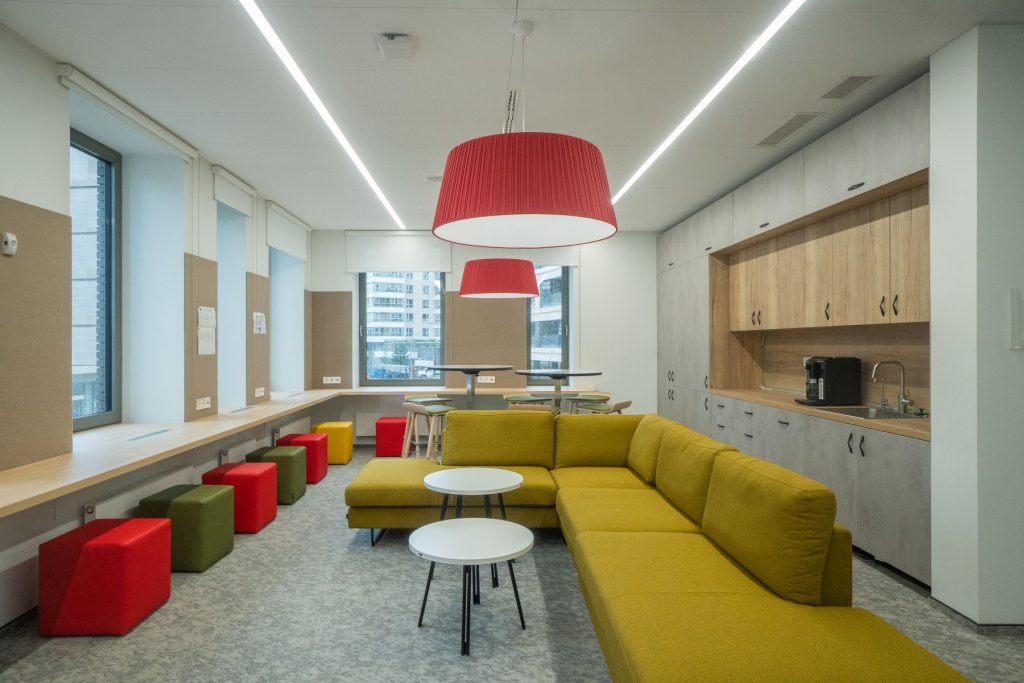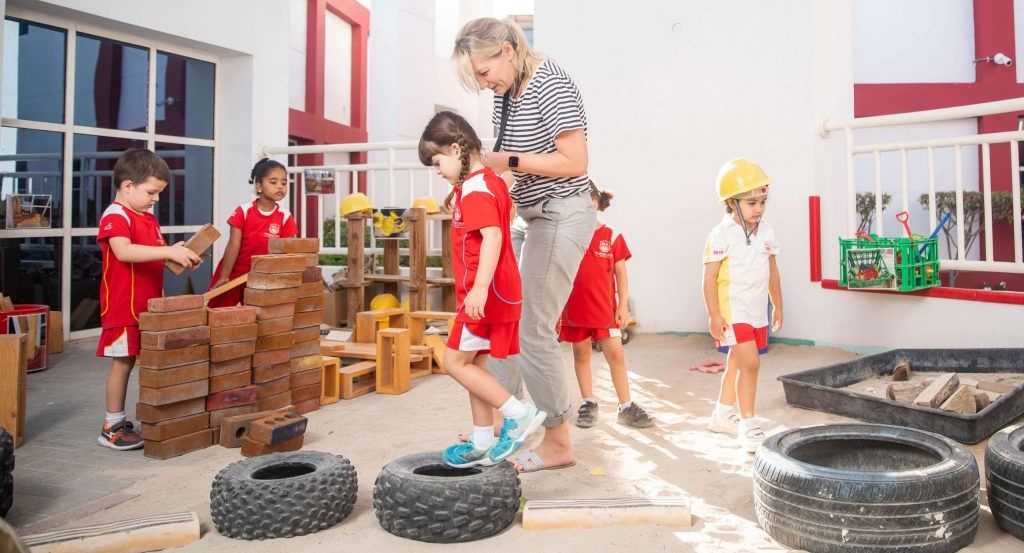In the dynamic landscape of modern education, the spotlight often shines on the transformation of classrooms into nurturing hubs for students’ growth and development. The concept of child-centered education has rightfully been placed in the limelight, heralding a new era of personalized learning and holistic development. However, amidst the fervor for student well-being, two pivotal components often remain in the shadows. Firstly, the resources for the mental well-being of the teachers and secondly, the provision of efficient and comfortable physical environments.
As schools evolve into vibrant ecosystems for young minds to flourish, it’s crucial not to overlook the educators who form the backbone of these environments. Teachers and staff invest a substantial portion of their days in fostering intellectual and emotional growth in students. This work is not just demanding; it’s intricate, emotionally charged, and intellectually stimulating. Educators not only impart knowledge but also play the role of mentors, guides, and caregivers, which requires a wealth of emotional resources.
Anjali Bajaj, who works at Bloom Education in the UAE and has been part of various schools in the past eight years believes that:
She says that she, “would appreciate if the schools and education sector can give as much importance to staff’s well-being as all other things in the school. Small steps and strategies such as professional development opportunities, mental health support, maintaining manageable workloads, and fostering a positive school culture can be a good start.”
Asma Khan*, one of the teachers at Emirates International School in the UAE, echoes the sentiments of Anjali. “The schools focus more on the well-being of the children, and do sometimes overlook the well-being of the teachers.”
However, Mark Ford, Principal of The English College (TEC), says his school in particular holds teacher well-being as integral to cultivating a holistic educational experience.
Defining Well-being in an Educational Context
Well-being, within the realm of education, extends far beyond the mere absence of illness. It encompasses a dynamic state of physical, mental, and emotional wellness that nurtures an individual's ability to flourish both personally and professionally.
![]()
For educators, well-being goes beyond their individual experiences; it radiates to impact the classroom atmosphere, student engagement, and the entire school ecosystem.
Anjali believes that “if a school is able to provide psychological support for teachers it can help them manage stress, cope with challenges in the classroom, and maintain a healthy work-life balance. This can also be one of the best ways in which the schools could retain their teachers.”
Asma highlights that provisions are in place for teachers’ well-being, “but in daily practical life, it just doesn’t work. It is always the case where teachers are the front line workers and are always directly in the line of fire, left to fend for themselves.”
Meanwhile Alison Roberts, Head of Marketing and Admissions at Swiss International Scientific School in Dubai (SISD) says well-being is pivotal to their culture.
Designing Teacher-Focused Spaces
In the world of modern education, the physical environment plays a crucial role in the well-being of teachers. Anna Shapiro, Chief Architect at EdDesign LLC, emphasizes the importance of providing educators with comfortable and functional spaces that go beyond the classroom. She notes,
Anna's projects prioritize the creation of teacher's offices that cater to the diverse needs of educators. These spacious rooms are thoughtfully designed with multiple zones. She explains, "Teacher's offices in our projects are spacious rooms with several zones: workplaces for individual work - they can be fixed or floating, such a place can be used by anyone who needs it now; a lounge zone is mandatory - where you can sit in a soft armchair or on a sofa, alone or with a colleague to discuss something in a more relaxed atmosphere."

Photo: Bullfinch School by EdDesign LLC
An integral feature of these teacher's offices is the inclusion of a kitchenette. Anna highlights the significance, saying, "A mandatory element of our teacher's offices is a kitchenette - it is an opportunity to drink hot tea or coffee without taking time off the work and a modest opportunity to share a meal with colleagues." These spaces are designed to foster a sense of community among educators, facilitating informal interactions and collaboration.
Furthermore, Anna's projects consider the need for meeting rooms and spaces for larger gatherings. She adds, "As a rule, teachers' offices are adjoined by small meeting rooms and a place for a large gathering of all teachers." This attention to detail ensures that educators have the facilities they require to work effectively and connect with their peers.

Photo: Formula School by EdDesign LLC
In one of their recent projects, Anna and her team even incorporated a gym exclusively for teachers. While it's expected that students will eventually use the space, the school's director recognizes the immediate value it brings to teacher well-being. Anna concludes, "The school is just starting up, and of course, we think that in time this gym will be occupied by students, but for now, the director is determined to keep it in place for the well-being of his teachers."
Mark from TEC throws light on the considerations that were taken into account when designing the physical spaces within the school to ensure they contribute to teacher well-being.
Meanwhile, Alison from SISD reveals: “We have large well-designed, and comfortable staff rooms, and a well-being quiet room for staff to relax. The well-being room is a No Device room, equipped with massage chairs, soft lighting and background music.
“We have a purpose-built staff accommodation on site, a range of 1-3 bedroom apartments and a private staff-only swimming pool. Staff can also use the full-size Technogym, cardio suite and Olympic-sized pool on campus.”

Photo: Swiss International Scientific School in Dubai (SISD)
Anjali emphasizes the need for well-built physical spaces including personal space and classrooms. “Personal spaces, such as a staff room are very important and every school should have a comfortable place where their staff can sit and have their little breaks in between lessons. A neat, clean and well-equipped staff room with some day-to-day pantry essentials can also help a teacher to calm herself down. Not all days are good for a teacher and in such situations, such personal physical spaces play an important role.”
Meanwhile, Asma praises her school for, “physical spaces which are well kept and stocked and they provide a good haven to relax and recuperate between lessons.”
Supporting Teachers' Mental Health
Given the complex and emotionally demanding nature of work in the modern educational landscape, it becomes imperative to consider the psychological well-being of teachers.
![]()
While the presence of psychologists in schools to aid students is not uncommon, the idea of extending this support to teachers might be met with curiosity. However, it's crucial to recognize that educators often grapple with stressors unique to their profession.
Balancing diverse classroom dynamics, adapting to rapidly evolving teaching methods, and managing parental expectations can take a toll on teachers' mental health.
Mark from TEC emphasizes the significance of not only in-school assistance but also the proactive cultivation of a sense of community and emotional support within his school's ethos.
He elaborates on this by highlighting the school's initiatives such as the ‘Gratitude Breakfast’, which creates an informal platform for networking and connection among staff members. Moreover, the institution promotes interaction and collaboration through regular team meetings and social events, fostering a supportive environment that goes beyond the classroom.
Photo: The English College (TEC)
Mark also highlights his school's role in providing psychological support in enhancing the overall work environment for teachers. “The school significantly emphasizes psychological support to improve the overall work environment. The English College provides access to medical insurance that covers mental health needs, and we are working to expand these services. By addressing mental health concerns, the school aims to ensure teachers have the necessary support to thrive in their roles.”
Alison highlights an impressive array of staff health and well-being initiatives by SISD. These include 'Be Good to Yourself Day,' allowing staff an extra day's leave to recharge. The 'Staff Peace Pod' offers a serene escape with massage chairs and soothing scents, while 'Sunrise Yoga' and 'Friday Zumba' sessions promote physical wellness. The 'Running Club' fosters camaraderie and fitness, and the 'Staff Book Club' encourages literary engagement. Staff also enjoy complimentary access to a well-equipped gym and sporting facilities. The 'Secret Buddy' program spreads cheer through notes and treats. Expressing gratitude, there are 'Staff Socials,' 'Birthday Shoutouts,' and a festive 'Secret Santa' tradition.

Photo: Swiss International Scientific School in Dubai (SISD)
On the other hand, Asma acknowledges the presence of a robust support system within her immediate team and under her direct line manager's guidance. However, she also acknowledges that not everyone within the educational community may enjoy “the same level of support”, indicating the importance of more widespread implementation of such support mechanisms.
However, such initiatives also come with attached challenges. Integrating psychological assistance into the school ecosystem requires financial and logistical considerations. Schools must weigh the cost against the potential benefits to both educators and students.
![]()
Meanwhile, teachers may be hesitant to open up about their struggles due to concerns about privacy. Schools need to ensure strict confidentiality protocols to create a safe space for teachers to seek help.
Also, different cultures have varied perspectives on mental health. Schools must navigate cultural nuances to provide support that aligns with diverse backgrounds.
The Teacher's Well-being and the Classroom
Anjali recognizes that her well-being, whether she realizes it or not, has a bearing on her students' journey. It's a sentiment echoed by Asma, who underscores the undeniable truth that educators, like all individuals, have their ups and downs. The classroom, in many ways, “becomes a microcosm of emotions, with students keenly attuned to the energies of their teachers. It's a subtle dance of emotions and energies, where the teacher's mood can set the tone for the day.”
![]()
Thus, teacher well-being directly and indirectly impacts the classroom atmosphere, influencing the receptivity and engagement of students.
While acknowledging the profound impact of teacher well-being, it's equally vital to explore how schools can foster a healthy work-life balance for their educators. The English College provides a compelling example, emphasizing the importance of boundaries in the digital age. “By limiting emails outside working hours and instituting clear email policies, the school respects teachers' personal time, a crucial element in maintaining balance,” says Mark.
Photo: the Swiss International Scientific School in Dubai
Alison explains that the key element that contributes to a healthy work-life balance for teachers in any school is the cultivation of a “culture where well-being is truly respected and appreciated, and it is not just a buzzword.”
“Retention has increased as well – the highest level since the school opened in 2005,” reveals Alison.
Realizing the Vision in the UAE
The Well Schools Network, a collaborative effort between the National Program for Happiness and Wellbeing and the Ministry of Education, has a robust mission. Its overarching goal is to enhance the overall learning experience for over 100,000 students across different educational stages while also focusing on the well-being of more than 9,000 teachers, as detailed on the ministry's official website.
At the heart of this initiative lies the ‘Teachers' pillar’, one of the four pillars that underpin the network's mission. This specific pillar seeks to achieve several critical objectives.
Firstly, it aspires to bolster the sense of recognition and positivity among teachers, acknowledging their vital role in shaping the future. It is also dedicated to cultivating a culture of health and wellness among educators, recognizing the interdependence between physical and emotional well-being.
Lastly, the Teachers' pillar is strategically designed to provide support and resources that help teachers effectively manage the pressures and demands of their profession. Through these multifaceted efforts, the Well Schools Network is not only committed to the betterment of students but also to the holistic development and welfare of the educators who guide them on their educational journey.
*Name changed for anonymity.
September 2023








